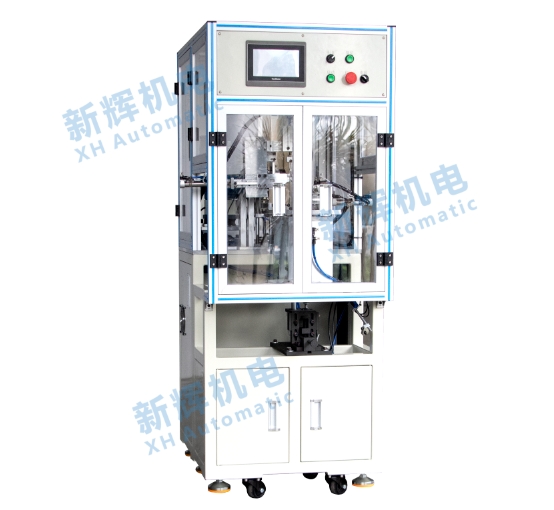Motor motor rotor automatic spring clamping machine how to carry out maintenance?
1、Routine maintenance
l Cleaning
External Cleaning: At the end of each day's work, use a clean soft cloth to wipe the external surface of the machine and clear away impurities such as dust, oil and metal shavings. Pay special attention to cleaning the area around key components such as control panels, sensors and motors, as dust and impurities may affect the normal operation of these components. For example, dust accumulating on sensors may cause signal transmission errors.
Internal cleaning: Periodically (e.g. once a week) open the protective housing of the machine and clean the interior using a compressed air spray gun. Focus on cleaning the drive mechanism, guide rails and screws to remove accumulated dirt and swarf. During the cleaning process, take care to avoid blowing impurities into sensitive parts such as motors and controllers.
l Check the connection of key components
Electrical connection: Before starting the machine every day, check whether the connection of the electrical wiring is firm, including plugs, sockets and terminals. Look for signs of looseness, oxidation or burning. If loose connections are found, they should be tightened in time; for oxidized connectors, professional electrical cleaners and tools can be used to clean and repair them.
Mechanical connections: Check the connections between mechanical parts such as bolts, nuts, couplings, etc. Make sure they are tightened without loosening to ensure the mechanical transmission precision of the machine. For frequent movement of the connection parts, such as the connection between the screw and the nut, pay special attention to check the lubrication and the degree of wear.

2、Regular maintenance (monthly or quarterly)
l Lubrication
Determine the lubrication point: Identify all the parts on the machine that need lubrication, such as bearings, gears, guide rails and screws. Generally, you can refer to the machine's manual to determine the location of specific lubrication points and lubrication requirements.
Choose the right lubricant: Select the right lubricant according to the working conditions and requirements of different parts. For example, for high-speed rotating bearings, high-temperature grease can be used; for guide rails and screws, lubricants may be required. When selecting lubricants, pay attention to their performance parameters, such as viscosity, anti-wear performance, etc.
Perform lubrication operation: lubricate according to the specified lubrication period and method. For some hard-to-reach lubrication points, you can use extension tubes or special lubrication tools to operate. In the lubrication process, add lubricant in the right amount to avoid too much or too little. Too much lubricant may lead to contamination and leakage, while too little will not provide a good lubrication effect.
l Checking and replacing wearing parts
Identify wearing parts: Understand which parts in the machine belong to wearing parts, such as belts, chains, jaws of circlip mounting tools, clamping jaws of fixtures, etc. These parts are prone to wear and tear during long-term use. These parts are prone to wear or damage during long-term use, affecting the normal operation of the machine.
Check the wear of wearing parts: Use calipers, micrometers and other tools to regularly measure the size of wearing parts and compare them with the original specifications to determine the degree of wear. At the same time, observe the surface condition of the wearing parts, such as whether there are cracks, deformation and so on.
Timely replacement of wearing parts: When the wear and tear of wearing parts reaches the specified limit or damage occurs, they should be replaced in time. When replacing the wearing parts, use good parts that meet the requirements of the machine and operate according to the correct installation method to ensure that the new parts can work properly.
3、Annual maintenance
l Calibration and precision adjustment
Mechanical precision calibration: Carry out precision calibration on the mechanical parts of the machine, including the straightness of the guide rail, the pitch precision of the screw, the positioning precision of the fixture, etc.. Measurement and adjustment can be carried out with professional inspection tools, such as level meter and laser interferometer. By adjusting the foot bolt, screw nut and other components, the mechanical accuracy of the machine is restored to the specified range.
Sensor calibration: Calibrate various sensors on the machine, such as position sensors and pressure sensors. According to the calibration procedure of the sensors, use standard calibration equipment or tools to adjust the zero point, range and sensitivity and other parameters of the sensors to ensure that the sensors can accurately detect and transmit signals.
l Electrical system inspection and maintenance
Controller Inspection: Perform a complete inspection of the machine's controller, including circuit board cleaning, electronic component inspection and software update. Open the controller case and use compressed air and electronic cleaner to clear away the dust and impurities on the circuit board. Check the electronic components for visible signs of damage, such as scorching and bulging. Also, update the software programs in the controller to fix known bugs and optimize performance.
Motor Maintenance: Perform maintenance on the motor, including cleaning the motor housing, checking the insulation resistance of the motor windings, and lubricating the motor bearings. Use an insulation resistance meter to measure the insulation resistance of the motor windings to ensure that it meets requirements. If the insulation resistance is too low, the motor may need to be dried out or repaired. Clean and relubricate the motor bearings to extend the life of the motor.
※ If the above ways and means still can not solve the equipment failure, please contact Xinhui Electromechanical Equipment Co., Ltd. technical specialists through the page chat tool for help.







